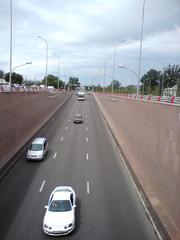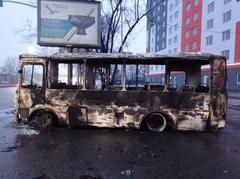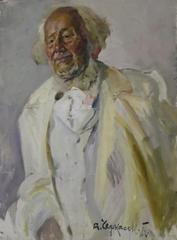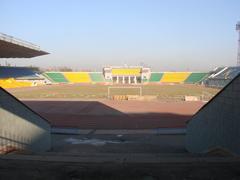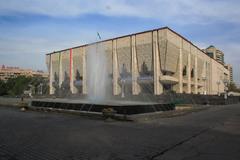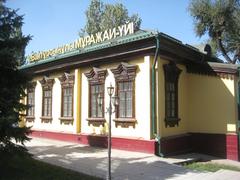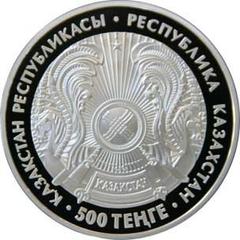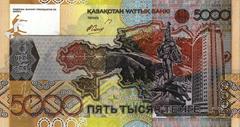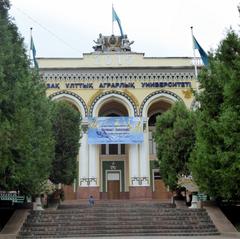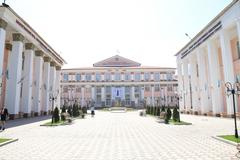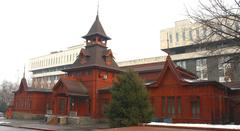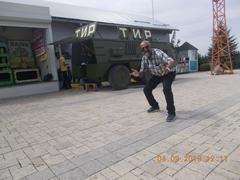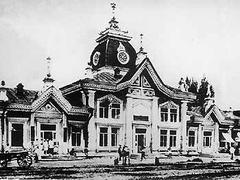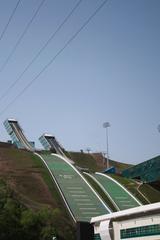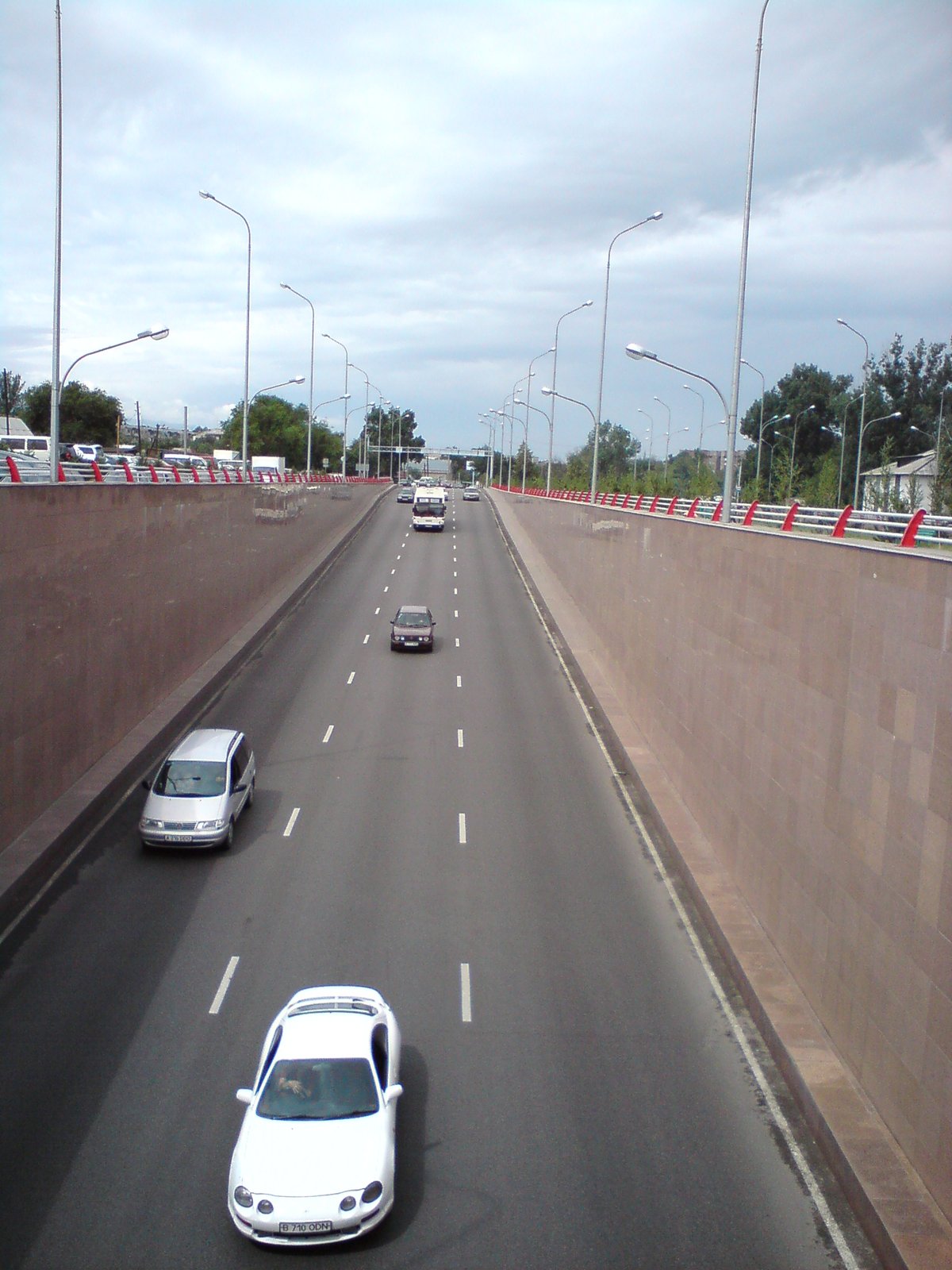
Rayimbek Avenue Visiting Hours, Tickets, and Travel Guide: Almaty Historical Sites
Date: 15/06/2025
Introduction: The Significance of Rayimbek Avenue in Almaty
Rayimbek Avenue is one of Almaty’s most prominent thoroughfares, where the city’s layered history converges with its dynamic present. Named after Rayimbek Batyr, a celebrated 18th-century Kazakh hero renowned for his role in liberating the Semirechye region, the avenue stands as a living tribute to Kazakhstan’s resilience and evolving identity. Its origins trace back to the 19th century during the Verny era, reflecting urban planning principles that integrated natural topography and irrigation, helping establish Almaty’s reputation as a “garden city” (Astana Times).
Over time, Rayimbek Avenue has witnessed dramatic transformations—from Soviet-era architectural projects and ideological renamings to a post-independence reclamation of Kazakh heritage. Today, it is not only a key transportation corridor but also a vibrant cultural hub, home to monuments, markets, parks, and religious sites that embody Almaty’s rich narrative (TravelSetu).
Rayimbek Avenue’s accessibility via the Rayimbek Batyr metro station and proximity to Almaty 1 train station ensure that all travelers can easily explore its iconic landmarks, such as the Raiymbek Batyr monument, Rayimbek Batyr Mausoleum, and Almaty Central Mosque. The avenue’s bustling markets and cultural events offer a sensory-rich experience, blending Kazakhstan’s traditions with modern city life (One in the Orange Jacket; Central Asia Guide).
This comprehensive guide provides essential details on visiting hours, tickets, transport, and nearby attractions, helping you fully immerse yourself in Almaty’s heart.
For deeper insights on Almaty’s historical sites, consult official tourism resources and consider guided tours (Astana Times; Almaty Tourism).
Contents Overview
- Early Urban Foundations and Verny Era
- Soviet Transformation and Renaming
- Rayimbek Batyr: The Avenue’s Namesake
- Urban Development and Modernization
- Visiting Rayimbek Avenue: Practical Information
- Visiting Hours and Accessibility
- Tickets and Guided Tours
- Transportation Options
- Nearby Attractions
- Cultural and Historical Significance
- Architectural Landmarks and Urban Fabric
- Rayimbek Avenue in Contemporary Almaty
- FAQ
- Notable Sites and Attractions Along Rayimbek Avenue
- Practical Visitor Tips
- Weather and Safety Considerations
- Cultural Etiquette
- Accessibility
- Events and Activities
- Dining, Shopping, and Accommodation
Early Urban Foundations and Verny Era
Rayimbek Avenue’s roots stretch to the 19th-century city plan of Verny (now Almaty). After becoming the administrative center of Semirechye (Jetisu) in 1867, city planners established a grid system, with streets oriented to the terrain and the Tien Shan mountains. A key innovation was the main canal from the Malaya Almatinka River, distributing water through subsidiary canals and fostering lush greenery. Regulations requiring homeowners to plant trees solidified Almaty’s “garden city” reputation. Rayimbek Avenue emerged from these early urban planning philosophies (Astana Times).
Soviet Transformation and Renaming
During the Soviet era, Almaty (then Alma-Ata) underwent major urban renewal, with the construction of monumental architecture and ideological renamings. The city absorbed waves of evacuees and deportees, transforming its cultural fabric. Rayimbek Avenue, like many streets, was renamed several times to honor Soviet figures and events. Soviet infrastructure investments laid the groundwork for today’s transportation corridors, including Rayimbek Avenue (TravelSetu).
Rayimbek Batyr: The Avenue’s Namesake
Rayimbek Batyr, the avenue’s namesake, is celebrated for his leadership against Dzhungarian invaders and is a symbol of Kazakh national pride. Appointed by Abylai Khan, Rayimbek Batyr’s legacy is enshrined in monuments and the Rayimbek Batyr metro station, which includes a portrait of the hero and a sculpture of Abylai Khan (Live the World).
Urban Development and Modernization
Rayimbek Avenue’s role as a principal east-west artery has endured, with infrastructure upgrades over time to support Almaty’s growth. During the Soviet period, it was widened and modernized, and in recent decades, improvements have focused on easing congestion and enhancing green spaces. Its proximity to major transport hubs like Almaty 1 train station and the Rayimbek Batyr metro station makes it a strategic route for locals and visitors (Astana Times).
Visiting Rayimbek Avenue: Practical Information
Visiting Hours and Accessibility
Rayimbek Avenue is open 24/7 year-round. Daytime visits are recommended for safety and to appreciate the avenue’s architecture and greenery. The avenue is wheelchair accessible, with ramps and crossings, especially near major intersections and metro stations.
Tickets and Guided Tours
No tickets are required to stroll the avenue or visit most monuments. Some attractions, such as museums, may charge a small fee. Guided tours can be booked through local operators for deeper historical context.
Transportation Options
- Metro: Rayimbek Batyr metro station (Green Line), operating 6:00 am–midnight (welcome.kz).
- Bus/Trolleybus: Multiple lines serve the avenue; fares range from 80–150 KZT.
- Taxi/Ride-sharing: Yandex Go, inDriver, and local taxis are easily available.
- Cycling: Bike-sharing stations are located along the avenue.
Nearby Attractions
Key nearby sites include the Green Bazaar, Central Mosque, Panfilov Park, and Rayimbek Batyr Monument.
Cultural and Historical Significance
Rayimbek Avenue represents Almaty’s multicultural history, traversing neighborhoods shaped by migration, trade, and political change. The avenue’s route reflects Silk Road heritage, Soviet modernization, and the current renaissance of Kazakh identity. It is also a focal point during citywide celebrations and festivals (Adventure Backpack).
Architectural Landmarks and Urban Fabric
While few 19th-century structures remain due to earthquakes and redevelopment, the avenue is lined with Soviet-era residential blocks and modern commercial centers. Notable landmarks include the Central Mosque and the Green Bazaar, both emblematic of Almaty’s evolving cityscape (Adventure Backpack).
Rayimbek Avenue in Contemporary Almaty
Rayimbek Avenue offers a microcosm of Almaty’s transformation—from Silk Road outpost to Soviet capital, to a modern metropolis. Its blend of street art, monuments, markets, and daily city rhythms invites exploration and reflection (Astana Times; TravelSetu).
Notable Sites and Attractions Along Rayimbek Avenue
Rayimbek Batyr Mausoleum
This modern white-marble mausoleum honors Rayimbek Batyr and is a site of pilgrimage and reflection. Open 9:00 am–6:00 pm, free entry, wheelchair accessible (Central Asia Guide).
Almaty Central Mosque
One of Kazakhstan’s largest mosques, featuring a blue dome and intricate tilework. Open to visitors (except during Friday prayers) from 10:00 am–5:00 pm, free entry, modest dress required (One in the Orange Jacket).
Green Bazaar (Zelyony Bazaar)
A bustling market for fresh produce, spices, and souvenirs. Open daily 8:00 am–7:00 pm (One in the Orange Jacket).
Park of 28 Panfilov Guardsmen
Accessible from the avenue, this park features memorials and the Zenkov Cathedral. Open year-round, free entry (My Wanderlust).
Soviet-Era and Modern Architecture
Soviet residential blocks and new commercial centers line the avenue, with some buildings adorned by contemporary murals (One in the Orange Jacket; Central Asia Guide).
Religious and Spiritual Sites
In addition to the Central Mosque, several Orthodox churches are located nearby, reflecting Almaty’s religious diversity (One in the Orange Jacket).
Art and Street Culture
Rayimbek Avenue features public art, murals, and hosts open-air events and festivals (MakeMyTrip; TripHills).
Transportation
The avenue is served by Almaty Metro (Rayimbek Batyr Station), bus and trolleybus routes, and bike-sharing options (My Wanderlust; Wanderon).
Practical Visitor Tips
- Best Time to Visit: Late spring to early autumn (May–September) for pleasant weather and outdoor events (Wanderlog).
- Safety: Generally safe; stay vigilant in crowded areas (One in the Orange Jacket).
- Language: Kazakh and Russian are common, with English spoken in tourist areas (Wanderon).
- Currency: Kazakhstani Tenge (KZT). ATMs and exchange offices available.
- Weather: June temperatures range 10–20°C, frequent rain; bring waterproof gear (weather-atlas.com).
- Connectivity: Free Wi-Fi in cafes; local SIM cards widely available.
Cultural Etiquette
Dress modestly near monuments and religious sites, and ask permission before photographing people. Respect local customs, especially at commemorative or spiritual locations (iie.kz).
Events and Activities
The avenue is a venue for parades, festivals, and ceremonies, especially around Rayimbek Batyr’s birth anniversary, showcasing Kazakh traditions, music, and cuisine (iie.kz).
Accessibility
Most sidewalks and public spaces are accessible, with metro elevators and ramps at key sites. Public restrooms are available in shopping centers and parks.
Dining, Shopping, and Accommodation
Rayimbek Avenue offers a variety of dining—from street food to upscale restaurants—serving both Kazakh and international cuisine. Cafes and bakeries provide snacks and coffee. Shopping options include supermarkets, specialty shops, and the Green Bazaar for local products.
For accommodation, the area is close to budget hostels, mid-range hotels, and serviced apartments, many with modern amenities (weather25.com).
Essential Contacts and Emergency Information
- Tourist Office: Visit Almaty, 44 Abay Avenue (welcome.kz)
- Emergency: Dial 112
- Taxi: Yandex Go and inDriver apps
Suggested Itinerary
- Morning: Arrive at Rayimbek Batyr Metro Station, visit the monument, enjoy breakfast at a local café.
- Midday: Explore Green Bazaar for shopping and lunch.
- Afternoon: Visit Panfilov Park and Central Mosque.
- Evening: Return for dinner or a stroll along Rayimbek Avenue.
Find more routes at Caravanistan’s walking guide.
Weather Considerations
June features long daylight hours and a high UV index (9). Sunscreen, sunglasses, and rain gear are recommended (weather-atlas.com).
Frequently Asked Questions (FAQ)
Q: What are the Rayimbek Avenue visiting hours?
A: The street and monuments are open 24/7; individual sites like the mausoleum and mosque have specific hours.
Q: Are there tickets required for attractions?
A: Most are free; museums may charge a small fee.
Q: How do I get to Rayimbek Avenue from the airport?
A: Taxi and ride-hailing apps offer 25–40 minute rides.
Q: Is Rayimbek Avenue accessible for travelers with mobility challenges?
A: Yes, with metro elevators, accessible sidewalks, and ramps at key sites.
Summary and Key Takeaways
Rayimbek Avenue is a living symbol of Almaty’s historical legacy and modern energy. Its monuments, markets, parks, and art reflect the city’s multicultural evolution. With excellent transportation links, accessible design, and proximity to top attractions, it is a must-visit for anyone seeking to experience Kazakhstan’s heritage and contemporary life (Live the World; Astana Times; Adventure Backpack; Central Asia Guide; TravelSetu; Almaty Tourism).
Sources
- Astana Times
- Live the World
- TravelSetu
- Adventure Backpack
- Central Asia Guide
- One in the Orange Jacket
- My Wanderlust
- Wanderon
- MakeMyTrip
- TripHills
- Explore Travel Oasis
- Welcome.kz
- welcome.kz
- travelseewrite.com
- weather-atlas.com
- Caravanistan
- Almaty Tourism
